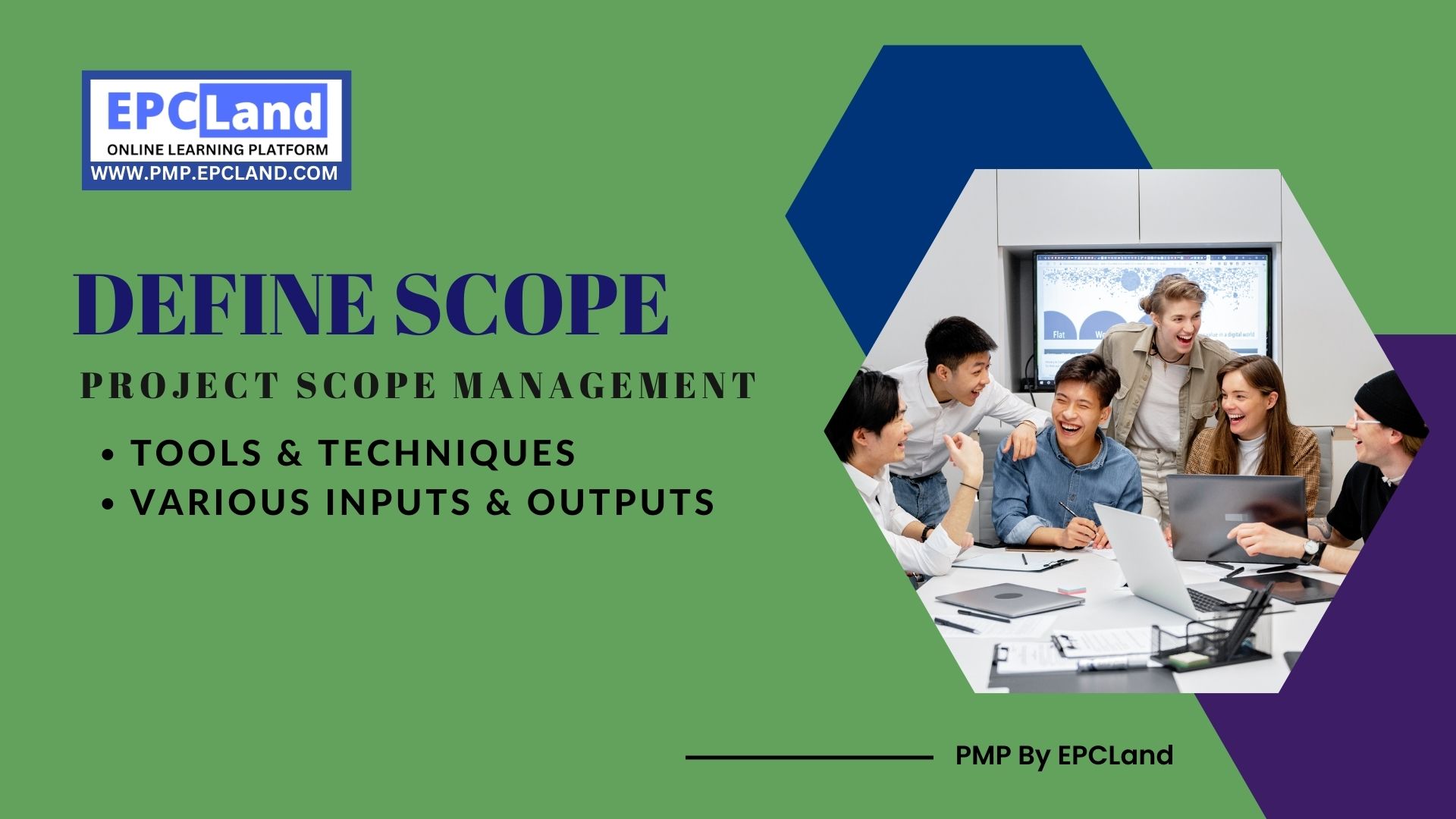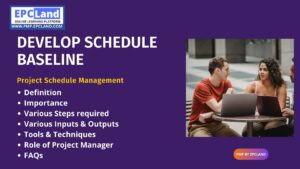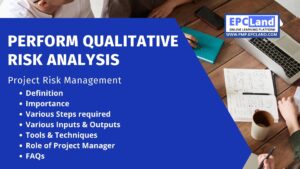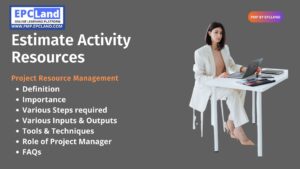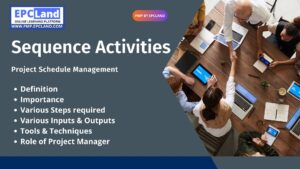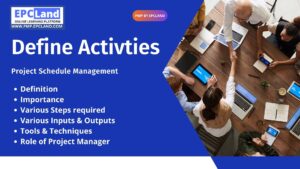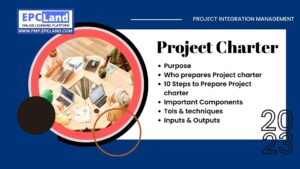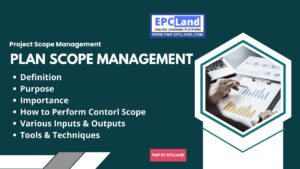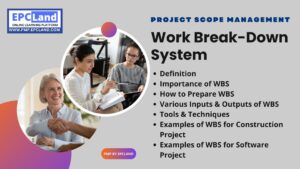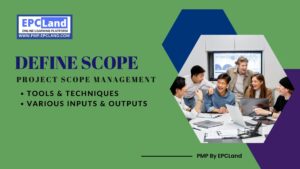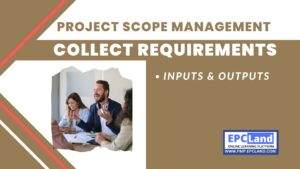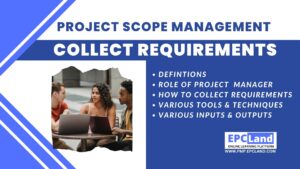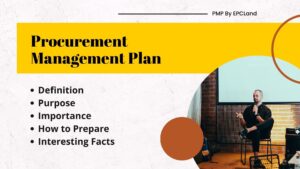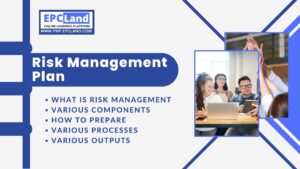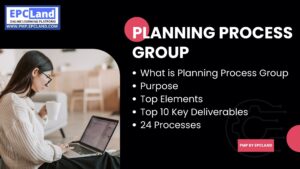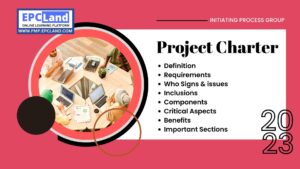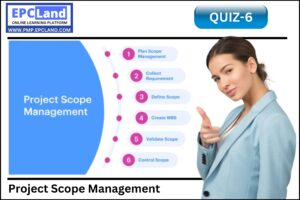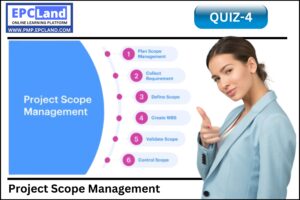Scope in project management refers to the specific goals, deliverables, tasks, and deadlines that make up a project. It defines the boundaries of the project and outlines what work needs to be done and what will be excluded. The process of defining scope involves identifying and documenting the project’s objectives, requirements, and constraints, and is typically completed during the planning phase of a project. The project scope statement, which is a document outlining the project’s scope, is an important tool for managing and controlling the project throughout its lifecycle.
Table of Contents
ToggleAttempt Quiz-1 on Define Scope Process

Time's up
Define Scope of Project – Inputs
The following are included in the defined scope process as the inputs:
- Project Charter
- The Project Management Plan
- Project Documents
- Enterprise Environmental Factors
- Organizational Process Assets
Don’t Miss the 1000+ MCQ questions & hundreds of quizzes on PMP Knowledge Areas and Various important sections.
Project charter : (1 of 5 Define Scope Inputs)
A project charter is a document that outlines the high-level objectives, deliverables, and stakeholders of a project. It is typically developed during the initiating phase of a project and serves as a foundation for the project’s planning and execution. A project charter should include the following information:
- Project purpose: A brief statement that describes the overall goal of the project and the business need it addresses.
- Project objectives: Specific and measurable objectives that the project is expected to achieve.
- Project deliverables: A list of the specific products, services, or outcomes that the project will produce.
- Project scope: A general description of the project’s boundaries, including what is included and what is excluded from the project.
- Stakeholder list: A list of the project’s stakeholders, including their roles and responsibilities.
- Project sponsor: The individual or group responsible for providing the project with the necessary resources and support.
- Project manager: The individual responsible for leading the project and ensuring that it stays on track.
The project charter serves as a starting point for the project and is used throughout the project to ensure that all stakeholders are aware of the project’s goals, deliverables, and boundaries.
Project Management Plan (PMP): (2 of 5 Define Scope Inputs)
A Project Management Plan (PMP) is a document that outlines how a project will be executed, monitored, and controlled. It is developed during the planning phase of a project and serves as a guide for managing and delivering the project. A PMP typically includes the following components:
Scope management plan: This outlines the processes and procedures that will be used to manage and control the project’s scope throughout its lifecycle.
Schedule management plan: This outlines the approach and tools that will be used to plan and control the project’s schedule.
Cost management plan: This outlines how the project’s budget will be managed and controlled.
Quality management plan: This outlines the approach and tools that will be used to ensure that the project’s deliverables meet the required quality standards.
Resource management plan: This outlines the approach and tools that will be used to manage and allocate the project’s resources.
Communication management plan: This outlines the approach and tools that will be used to manage and control the project’s communication.
Risk management plan: This outlines the approach and tools that will be used to identify, assess, and manage the project’s risks.
Procurement management plan: This outlines the approach and tools that will be used to manage the project’s procurement activities.
The PMP is a key tool for managing and controlling the project throughout its lifecycle and helps to ensure that the project is delivered on time, within budget, and to the required quality standards.
Project documents: (3 of 5 Define Scope Inputs)
These are a collection of documents that are created and used throughout the lifecycle of a project. These documents serve as a reference for project information and help to ensure that the project is executed, monitored, and controlled effectively. Some common types of project documents include:
Project charter: This document outlines the high-level objectives, deliverables, and stakeholders of a project.
Project management plan: This document outlines how a project will be executed, monitored, and controlled.
Scope statement: This document outlines the project’s objectives, deliverables, and constraints in a clear and concise manner.
Work breakdown structure (WBS): This document is a hierarchical breakdown of the project’s deliverables and tasks, which helps to organize and plan the work needed to complete the project.
Gantt Chart: This document is a graphical representation of the project schedule, showing the start and end dates of each task, and dependencies between tasks
Risk Register: This document lists all identified risks associated with the project, including the likelihood and impact of each risk and the planned response to each risk.
Issues log: This document lists any issues that arise during the project, along with the status of each issue and the actions taken to resolve it.
Change log: This document records any changes made to the project, including the reason for the change, the impact of the change, and the approval status of the change.
Project status report: This document provides an overview of the project’s progress, including any issues or risks, and the status of the project’s deliverables.
Project closure report: This document summarizes the project’s performance, including a summary of the project’s objectives, deliverables, and outcomes.
These documents are used by project managers, stakeholders, and team members to plan, execute, monitor, and control the project effectively.
Risk Register: (4 of 5 Define Scope Inputs)
A risk register is a document that is used to identify, assess, and manage risks associated with a project. In the context of scope management, a risk register can be used to identify potential risks that could impact the project’s scope, such as changes to the project’s requirements or delays in completing certain tasks.
The risk register typically includes the following information:
Risk identification: A list of all risks identified for the project, including those that could impact the project’s scope.
Risk assessment: An evaluation of the likelihood and impact of each risk, including the potential consequences if the risk occurs.
Risk response: A description of the planned response to each risk, including measures to prevent or mitigate the risk, and contingency plans in case the risk occurs.
Risk owner: The individual or group responsible for managing and monitoring the risk.
Risk status: The current status of the risk, including whether it has been resolved or is still active.
The risk register is used to track and manage risks throughout the project, and it is reviewed and updated regularly as new risks are identified or the status of existing risks changes. This helps to ensure that the project’s scope is not impacted by unplanned events and that the project stays on track to achieve its objectives.
Enterprise Environmental Factors (EEFs): (4 of 5 Define Scope Inputs)
Enterprise Environmental Factors (EEFs) in project management refer to the external factors that can affect a project’s outcome. These factors can be classified into two categories:
Organizational: These factors include the company’s culture, structure, and policies that can affect the project’s performance. For example, if the company has a strict risk management policy, it will be easier to manage risks on the project.
External: These factors include the industry, market, and economic conditions that can affect the project’s performance. For example, if the project is in a highly regulated industry, there will be more compliance requirements that need to be considered.
EEFs are considered during the project planning phase, and their potential impact on the project is evaluated. This information is used to develop the project management plan, and to identify and manage risks.
Examples of EEFs are:
- Government regulations
- Industry standards
- Legal requirements
- Market conditions
- Organizational culture, policies and structure
- Infrastructure and facilities
- IT capabilities
- Access to human resources and skills
EEFs are monitored throughout the project, and any changes that could impact the project are taken into account. This helps to ensure that the project is executed in a way that is consistent with the company’s culture and policies, and that it takes into account any external factors that could affect its outcome.
Organizational Process Assets (OPAs): (5 of 5 Define Scope Inputs)
Organizational Process Assets (OPAs) in project management refer to the internal resources that an organization has available to support its projects. These assets include the company’s policies, procedures, templates, and historical information that can be used to plan, execute, and control projects.
Some examples of OPAs include:
Project management templates: These templates can be used to create project documents, such as the project charter, project management plan, and status reports.
Historical information: This information includes data from previous projects, such as project schedules, budgets, and performance data. This information can be used to develop more accurate project estimates and to identify potential risks.
Procedures and standards: These include the company’s procedures for managing and controlling projects, as well as any industry standards that need to be followed.
Knowledge management systems: This include company’s systems that store, organize, and make accessible the company’s knowledge, skills and experience.
Training material: This includes any materials that are used to train employees on project management processes and techniques.
OPAs are considered during the project planning phase, and their potential impact on the project is evaluated. This information is used to develop the project management plan, and to identify and manage risks. OPAs are also used throughout the project to support the project execution and to ensure that the project is executed in a way that is consistent with the company’s culture and policies.
Define Scope Tools and Techniques
The “Define Scope” process in project management involves identifying and documenting the specific goals, deliverables, and tasks that are required to complete the project. The tools and techniques used in this process include:
Scope statement:
This document outlines the project’s objectives, deliverables, and key milestones. It is used to define the scope of the project and to establish a common understanding of what the project is expected to achieve.
Work breakdown structure (WBS)
This tool is used to divide the project into smaller, more manageable tasks and deliverables. The WBS helps to ensure that all aspects of the project are identified and included in the scope statement.
Product analysis
This technique involves analyzing the project’s deliverables to identify their characteristics and requirements. This information is used to develop the scope statement and to ensure that the project’s deliverables meet the needs of the stakeholders.
Scope management plan
This document outlines the project’s scope management processes, including how changes to the scope will be controlled and managed.
Expert judgment
This technique involves seeking input from experts in the relevant fields to help identify and define the project’s objectives and deliverables.
Facilitation techniques
This technique is used to involve stakeholders in the scope definition process, to ensure that their needs and expectations are taken into account.
Historical information
This technique involves reviewing the scope, cost, and schedule information from previous similar projects to help identify potential risks and to develop more accurate project estimates.
These tools and techniques are used in combination to ensure that the project’s scope is clearly defined and that all stakeholders have a common understanding of what the project is expected to achieve.
Attempt Quiz-2 on Define Scope Process

Time's up
Define Scope of Project – Outputs
The “Define Scope” process in project management produces several outputs, including:
Scope statement
This document outlines the project’s objectives, deliverables, and key milestones. It is used to define the scope of the project and to establish a common understanding of what the project is expected to achieve.
Work breakdown structure (WBS)
This tool is used to divide the project into smaller, more manageable tasks and deliverables. The WBS helps to ensure that all aspects of the project are identified and included in the scope statement.
Scope management plan
This document outlines the project’s scope management processes, including how changes to the scope will be controlled and managed.
Requirements documentation: This document describes the specific requirements for the project’s deliverables, including functional, performance, and interface requirements.
Project documents updates
The project charter, stakeholders register, and other project management plan documents are updated to reflect the project scope definition.
Baseline of project scope
The project scope statement, WBS and requirements documentation forms the basis for the project scope. Any changes to these documents will be managed and controlled through the change control process.
Stakeholder agreement
The scope statement and other project documentation are reviewed and approved by stakeholders to ensure that they are aligned with their expectations.
These outputs serve as the foundation for the rest of the project and guide the project team in the planning, execution, and control of the project. They also provide a clear and measurable way to determine if the project goals have been met.
FAQs on "Define Scope" in Project Scope Management
What is the definition of “Scope” in project management?
Scope refers to the boundaries and requirements of a project, including what work will be performed and what deliverables will be produced.
Why is defining scope important in project management?
Defining scope helps to establish clear expectations and goals for the project, and ensures that resources are used effectively. It also helps to prevent scope creep, which occurs when the scope of the project changes and grows beyond what was originally intended.
What are the steps involved in defining project scope?
The steps involved in defining project scope include defining the project objectives, identifying project deliverables, determining project constraints and assumptions, and creating a project scope statement.
How does a project scope statement help in project management?
A project scope statement provides a clear and concise description of the project’s objectives, deliverables, and boundaries. It helps to ensure that all stakeholders have a shared understanding of the project’s goals and objectives.
What is scope creep and how can it be prevented?
Scope creep occurs when the scope of the project changes and grows beyond what was originally intended. It can be prevented by regularly reviewing the project scope statement, closely managing changes to the project plan, and communicating clearly with all stakeholders.
